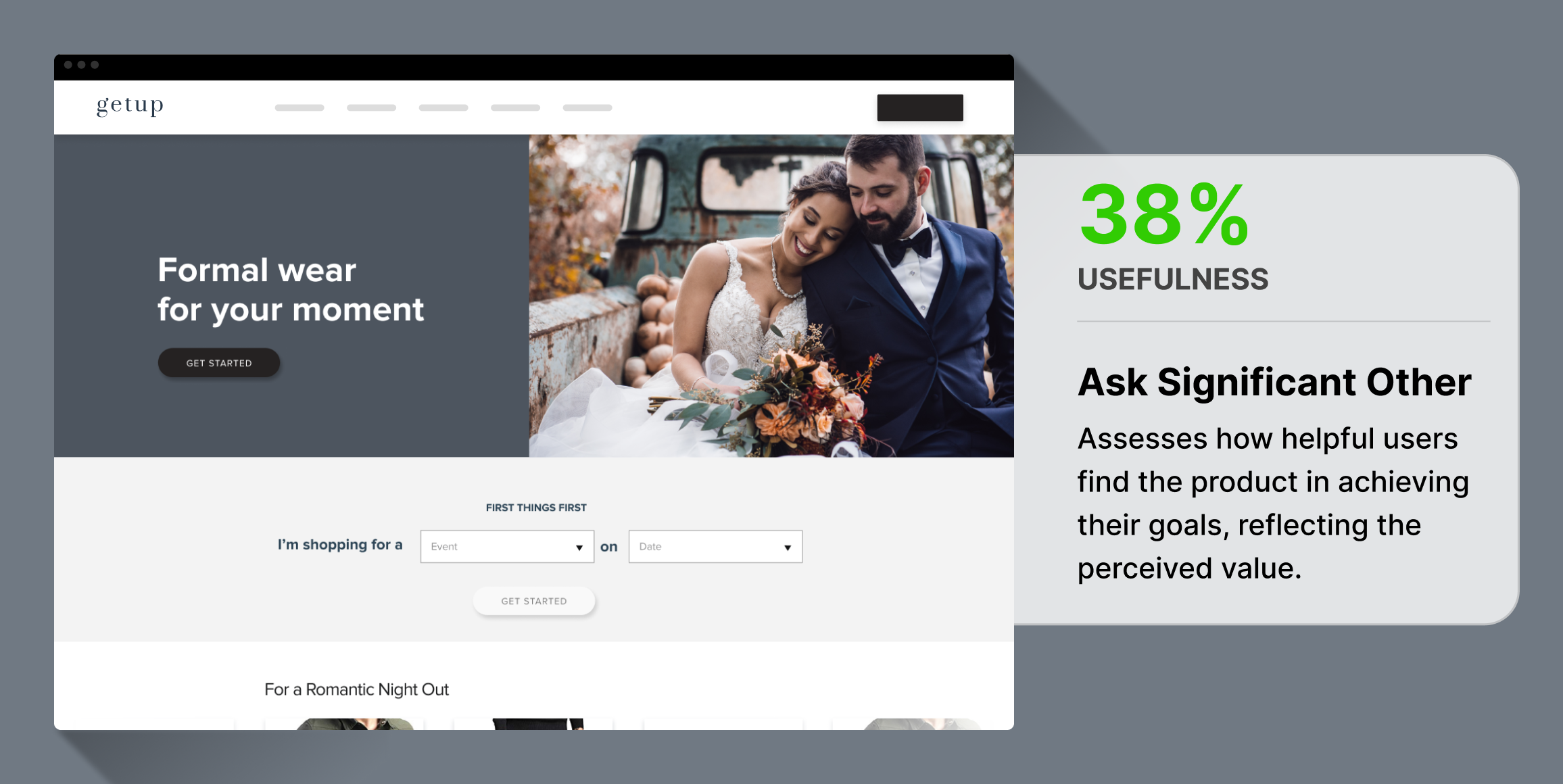Research Study
Getup Action Mapping
Testing journey maps for an e-commerce company using Action Mapping


38% of consumers would ask their significant other when looking for style advice.
Asking an S.O. was the majority decision, followed by online research (30%) and asking an online expert (15%).
49% of consumers would go to the nearest clothing store when buying a new suit.
This is significantly more than those who would purposely seek out a high quality clothing store.
33% of consumers would buy a new suit when going to a formal event.
This is a significant amount, just less than the majority (42%) who would simply wear an old suit.
Business Challenge
Getup, a formalwear clothing brand, We conducted a study to better understand the decision-making processes of consumers for a theoretical formalwear clothing brand called Getup. We wanted to understand how consumers would make decisions when engaging in various scenarios related to purchasing or renting formal attire. The challenge was to identify the most popular consumer actions to optimize marketing strategies and enhance user experience on digital platforms.
Timeline
Over the course of 24 hours, we determined the key scenarios that would matter to a formalwear e-commerce company, and put them into a Helio test. By the next day, we had received 200 responses from our audience and were able to construct a framework to outline consumers’ decision-making.
Research Goals
The objectives of the research were to:
- Map out consumer preferences for various actions related to buying, renting, or replacing formalwear.
- Determine the most preferred platforms (in-store, online) for these actions.
- Use these insights to guide improvements in service offerings and digital experiences
Methodology
We used an Action Map testing framework, which assessed the likelihood of consumers choosing specific actions across different scenarios. This approach involved collecting quantitative data on consumer preferences and mapping out the predominant pathways consumers take in decision-making processes.

Research Panel
We used a Helio ready-made audience of Male Formalwear Online Shoppers in the US. One hundred participants reacted to each of the seven scenarios we tested.
Test Setup
Participants were presented with several scenarios, including buying a new suit, replacing items in their wardrobe, renting an outfit, and attending a formal event.

They were asked to select their preferred actions from multiple options, such as purchasing in-store or online, renting, or using existing wardrobe items.

Analysis and synthesis
38% of consumers would ask their significant other when looking for style advice.

Asking an S.O. was the majority decision, followed by online research (30%) and asking an online expert (15%). Notable preferences were highlighted for borrowing or reusing items from one’s wardrobe for formal events, indicating a potential area for promoting sustainability in fashion.
49% of consumers would go to the nearest clothing store when buying a new suit.

This is significantly more than those who would purposely seek out a high quality clothing store. This showed a strong preference for in-store interactions when it came to immediate needs such as renting an outfit or buying a new suit.
33% of consumers would buy a new suit when going to a formal event.

This is a significant amount, just less than the majority (42%) who would simply wear an old suit. Online platforms were favored for convenience when buying a suit, but lacked the appeal of tactile and visual confirmation provided by in-store experiences.
Outputs/Deliverables
The study produced several key outputs:
- A detailed report with comprehensive analysis of consumer action preferences.
- An Action Map visualizing the most likely consumer pathways in various scenarios.
- Strategic insights into enhancing digital and physical touchpoints to better meet consumer preferences.
Next Steps and Recommendations
Based on the findings, the following recommendations were made:
1. Enhance the in-store experience to leverage consumer preference for tactile interactions, especially for urgent or significant purchases.
2. Improve online platform interfaces to simulate the in-store experience more effectively, possibly through VR or AR technologies.
3. Develop marketing strategies that emphasize the availability and convenience of various purchasing and rental options.
4. Consider a campaign focusing on sustainability by promoting the reuse and recycling of formal attire.
Reflections
This case study highlights the critical role of understanding consumer behavior in multiple scenarios to effectively tailor a brand’s offerings. Getup’s commitment to aligning their strategies with consumer preferences ensures their position as a responsive and customer-oriented brand in the competitive formalwear market. The insights from the Action Map testing provide a solid foundation for strategic improvements in both digital and physical consumer interactions.


